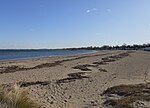Quincy School
1906 establishments in MassachusettsBuildings and structures in Quincy, MassachusettsColonial Revival architecture in MassachusettsNational Register of Historic Places in Quincy, MassachusettsNorfolk County, Massachusetts Registered Historic Place stubs ... and 3 more
School buildings completed in 1906School buildings on the National Register of Historic Places in MassachusettsSchools in Norfolk County, Massachusetts

Quincy School is a historic school building at 94 Newbury Avenue in Quincy, Massachusetts. The two-story brick building was built in 1906 and enlarged in 1932; its original design was by Hurd & Gore, and the addition was by Hutchins & French. A longtime elementary school, it closed in 1981 following city cutbacks in the wake of Proposition 2 1/2, and was subsequently sold to private developers for conversion to condominiums. The building was listed on the National Register of Historic Places in 1983.
Excerpt from the Wikipedia article Quincy School (License: CC BY-SA 3.0, Authors, Images).Quincy School
Newbury Avenue, Quincy North Quincy
Geographical coordinates (GPS) Address External links Nearby Places Show on map
Geographical coordinates (GPS)
| Latitude | Longitude |
|---|---|
| N 42.280555555556 ° | E -71.028611111111 ° |
Address
Quincy School
Newbury Avenue 94
02171 Quincy, North Quincy
Massachusetts, United States
Open on Google Maps








